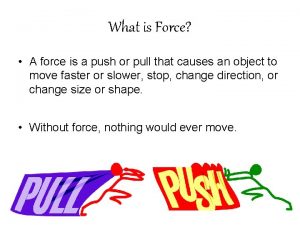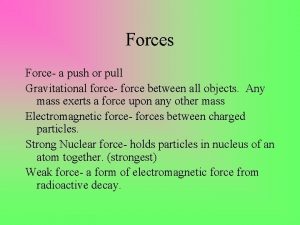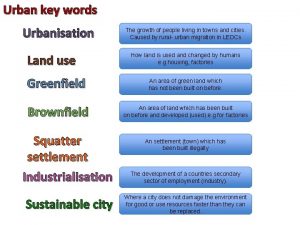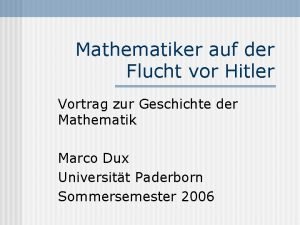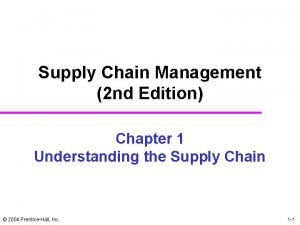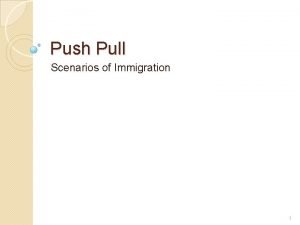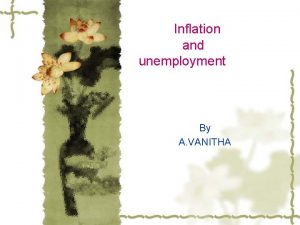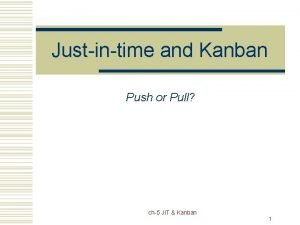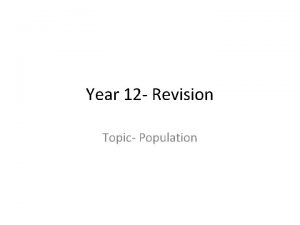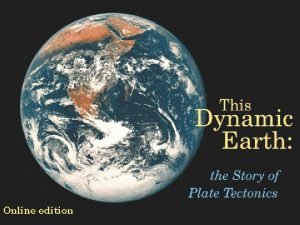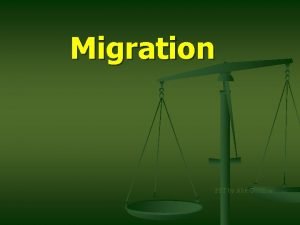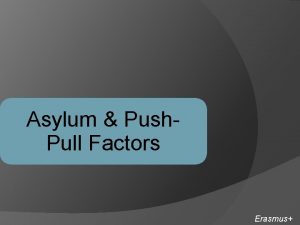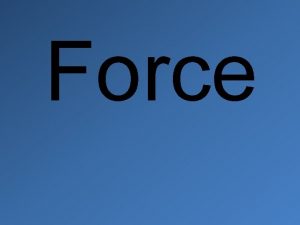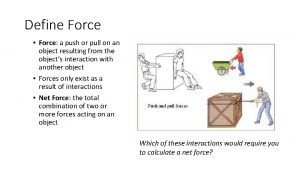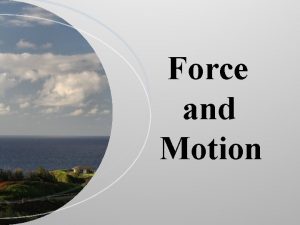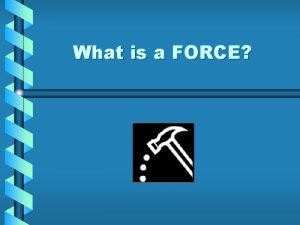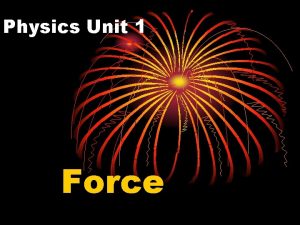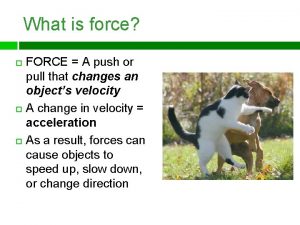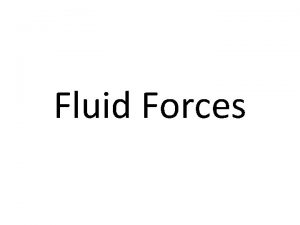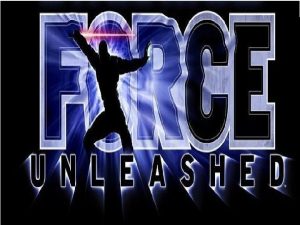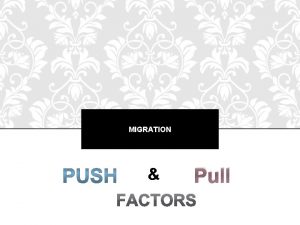push or a pull I A force F

















- Slides: 17

push or a pull I. A force, F, is a ______________. vectors A. Forces are _______. strong or weak • magnitude – how __________ arrow shows dir. of push/pull • direction –_____ Ex 1: F = 20 N, east mag. Sketch: dir. Ex 2: w = 10 N (down) mag. dir. 10 N 20 N newtons, N SI force units_________ (derived) 1 N = 1 kg m/s 2 fundamental stick of butter/small apple 1 N ≈ weight of 1___________

Ex. Woods pushes Siudy with a 25 N force to the right. Stolarski pulls Siudy with a 25 N force to the right. Draw and label both forces using a scale of 1 cm = 5 N. Siudy 25 N Woods Stolarski exactly the same These two forces are drawn __________ mag. & ______ dir. b/c they have the same _____. exert a force on Woods and Stolarski are said to _____ apply a force to Siudy. We say the forces or ______ act on. Siudy. Sometimes, forces are ______ actions called______.

Fundamental B. ______________ forces: basic • most _______ forces known without • can push or pull _______physical contact. at a distance field • aka “__________” or “ _____ ” forces Earth Ex. Even though ______ is separated from the Moon vacuum _________ by a ______ (nothing), exert forces both objects are able to ___________ on each other. F E F m ¼ million miles

fundamental The 4 _________ forces are listed below from strongest to weakest: strong (nuclear) –force that binds _____ protons 1. _____ nucleus and ______ within the _______ neutrons electromagnetism 2. ___________ (e&m)- the force that acts electric between _______ charges; the source of bonds _______ ; responsible for chemical ____ magnetism molecules atoms or between _________ between _____ weak decay 3. _____ (nuclear)– causes nuclear _____ gravity masses 4. _____ – (Fg) a force between ______ holds planets, solar systems, and galaxies weakest of the 4 here together, but is the _____________ weight aka the _______ (w) of an object when it is on w or Fg planet or near a_______.

Contact C. ________ forces between 2 objects: electromagnetism • result from______________ physical contact • occur when there is _________ Tension 1. __________, T: pull • the _______ of wires, ropes, strings, cables, etc direction • _______ is the direction of the wire, etc length • _______ of wire, rope, etc, not important electron bonding • results from ____________ between within atoms and molecules _____ the wire itself. Ex: ceiling wire weight T tension The ______ is the force exerted by the wire as it pulls up ________on the weight.

Friction 2. _______, Ff : opposes motion (or ______ intended • usually ______ motion) opposite of velocity • direction - usually _______ along the surface • acts ___________ between 2 objects bonds • sliding friction: results as electron ____ between the molecules along the surface break and re-form _____________. v Ex: block sliding along floor to the right. pulls back The surface ________ left to the ____ on the block Ff

Ex: block being pulled up an incline (ramp) Ex: block at rest on an incline v Ff v=0 Ff ______ friction, the block would slide down. Without intended This would be its "________ " motion. prevents Friction ______ that motion from happening, up the incline so friction must be directed __________.

Sometimes friction actually is in same the_____ direction as motion. Ex: block accelerated by pulling surface under it: block surface No friction: Friction: pull here… block remains at rest block is pulled along With respect to the surface, the block's intended motion is to the _______. So the friction must be to left opposing right the ______. Instead of _______ motion, in this case friction ______ causes motion: The accelerates to the right. block _________

3. The ________ force, FN : normal surfaces • occurs when 2 ________ are in contact perpendicular • direction is _________ ( ) to both surfaces stretch as • results when electron bonds _______ press against surfaces ____________ each other Ex: standing on floor FN pushes The floor _____ the person on ________. Ex: block at rest on an incline FN pushes The incline _____ the block on ________.

more than 1 D. Usually _________ force acts on an "Free body" diagrams make object at a time. ________ it easier to solve these problems. Rules for drawing free-body diagrams: surface 1. Imagine a _______ surrounding the object. 2. List all: contact a/ "_______" forces that cut through it at a distance b/ "_________" forces that cut through it point 3. Draw a ________ to represent the object. arrow 4. Draw each force in step 2 as an ______ point whose tail begins at that _______. v's, d's , etc ! F's. Do NOT draw _______ 5. Only draw _____

Ex: Mr. Siudy holds himself on a hillside by pulling on a rope. ro pe Drawing or sketch of object with many forces acting on it: Free body diagram (FBD) of same object: FN T Ff hill w

Draw a FBD of the forces acting on the blocks in each case below. Ex 1: block in free fall (no air resistance) w Ex 2: block on table at rest FN w Ex 3: block hanging from a wire: ceiling T w

Ex 4: block pulled to left on frictionless table by a pull P Ex 5: block on table sliding to the left, no pull, but with friction P FN P w FN v w not drawn Notice: v is ________ ! Ex 6: block on floor being pulled to left by a rope but not moving rop e Ff T FN w Ff

E. Forces can be added like any other vectors: Add: head to tail: F 1 and: F F 2 parallelogram: F q F 1 Magnitude of resultant force: F = √(F 12 + F 22) Direction of resultant force: q = tan-1(F 2/F 1) F 2

Ex: The resultant of two forces, 3 N and 4 N as a function of q between them: q ( 0) Magnitude of resultant F: Resultant F 0 7 N F 90 5 N 180 F 1 N add Biggest possible magnitude _____ the magnitudes subtractthe magnitudes Smallest possible magnitude _____ As q increases, the magnitude ________ decreases.

resolved F. Forces can be ________ (broken down into ___________ )like any other vectors: x and y components F Fy q Fx Phys. RT: (Mechanics section) Fy = F sinq Fx = F cosq

Ex: Find the x and y components of the F below: 120 N Fy 300 Fx Fy = = F sinq 120 N sin 300 120 (0. 500) 60 N Fx = = F cosq 120 N cos 300 120 (0. 866) 104 N
 Type of force applied
Type of force applied Is gravitational force a push or pull
Is gravitational force a push or pull Types of angle of pull
Types of angle of pull Curitiba sustainable city
Curitiba sustainable city Different influencing styles
Different influencing styles Was sind push und pull faktoren
Was sind push und pull faktoren Kanban push pull
Kanban push pull Push and pull chapter 7
Push and pull chapter 7 Push pull feedback
Push pull feedback Cycle view of supply chain
Cycle view of supply chain Push and pull scenarios
Push and pull scenarios Types of unemployment
Types of unemployment Jit
Jit Push and pull factors of urbanisation
Push and pull factors of urbanisation Push pull profile strategies marketing communications
Push pull profile strategies marketing communications Slab pull
Slab pull Promotion mix
Promotion mix Push and pull factors of migration ppt
Push and pull factors of migration ppt
